Synthesis, Characterization, and Properties of Novel Coplanar Bicyclic Compounds Based on Triazolofurazane Compounds
Abstract
1. Introduction
2. Results and Discussion
2.1. Synthesis of Energetic Compounds
2.2. X-Ray Structure Analysis
2.3. Energetic Performance and Safety
3. Materials and Methods
3.1. Reagents and Instruments
3.2. Synthesis of 4-Amino-5-(4-amino-1,2,5-oxadiazol-3-yl)-2,4-dihydro-3H-1,2,4-triazol-3-one (1)
3.3. Synthesis of N-(4-(5-oxo-4,5-dihydro-1H-1,2,4-triazol-3-yl)-1,2,5-oxadiazol-3-yl)nitramide (2)
3.4. Synthesis of Ammonium Nitro(4-(5-oxo-4,5-dihydro-1H-1,2,4-triazol-3-yl)-1,2,5-oxadiazol-3-yl)amide (3)
4. Conclusions
Supplementary Materials
Author Contributions
Funding
Institutional Review Board Statement
Informed Consent Statement
Data Availability Statement
Conflicts of Interest
References
- Fershtat, L.L.; Makhova, N.N. 1,2,5-Oxadiazole-based high-energy-density materials: Synthesis and performance. ChemPlusChem 2020, 85, 13–42. [Google Scholar] [CrossRef]
- Vinogradov, D.B.; Fershtat, L.L. Energetic azine N-oxides: State-of-the-art achievements in the synthesis and performance. Chem. Eng. J. 2024, 504, 158859. [Google Scholar] [CrossRef]
- Dong, W.-S.; Zhang, P.-P.; Xu, M.-Q.; Lu, Z.-J.; Li, Z.-M.; Wang, K.; Yu, Q.-Y.; Zhang, J.-G. One-pot synthesis of innovative multicomponent complexes as catalysts for enhanced decomposition of ammonium perchlorate. Small 2025, 21, 2411382. [Google Scholar] [CrossRef] [PubMed]
- Fischer, D.; Klapotke, T.M.; Stierstorfer, J. 1,5-Di(nitramino)tetrazole: High sensitivity and superior explosive performance. Angew. Chem. Int. Ed. 2015, 54, 10299–10302. [Google Scholar] [CrossRef]
- Yadav, A.K.; Ghule, V.D.; Dharavath, S. Thermally stable and insensitive energetic cocrystals comprising nitrobarbituric acid coformers. Cryst. Growth Des. 2023, 23, 2826–2836. [Google Scholar] [CrossRef]
- Tang, Y.; He, C.; Imler, G.H.; Parrish, D.A.; Shreeve, J.M. Ring closure of polynitroazoles via an N,N′-alkylene bridge: Towards high thermally stable energetic compounds. J. Mater. Chem. A 2018, 6, 8382–8387. [Google Scholar] [CrossRef]
- Chang, J.; Xiong, J.; Jia, H.; He, C.; Pang, S.; Shreeve, J.M. Polyiodo azole-based metal–organic framework energetic biocidal material for synergetic sterilization applications. ACS Appl. Mater. Interfaces 2023, 15, 45668–45675. [Google Scholar] [CrossRef]
- Fischer, D.; Klapotke, T.M.; Stierstorfer, J. Potassium 1,1′-dinitramino-5,5′-bistetrazolate: A primary explosive with fast detonation and high initiation power. Angew. Chem. Int. Ed. 2014, 53, 8172–8175. [Google Scholar] [CrossRef]
- Hu, L.; Staples, R.J.; Shreeve, J.M. Energetic compounds based on a new fused triazolo[4,5-d]pyridazine ring: Nitroimino lights up energetic performance. Chem. Eng. J. 2021, 420, 129839. [Google Scholar] [CrossRef]
- Zhang, J.; Zhang, J.; Singh, J.; Wu, W.; Staples, R.J.; Zhang, J.; Shreeve, J.M. Highly stable poly-nitro components achieved through supramolecular encapsulation. J. Mater. Chem. A 2024, 12, 5918–5923. [Google Scholar] [CrossRef]
- Qin, Y.; Yang, F.; Chen, Z.; Lu, M.; Wang, P. Revealing the electro-oxidation mechanism of 5-aminotetrazole on nickel-based oxides and synthesizing 5,5′-azotetrazolate salts. Inorg. Chem. 2024, 63, 12299–12308. [Google Scholar] [CrossRef]
- Xu, M.; Dong, W.-S.; Tariq, Q.-u.-N.; Lu, Z.-J.; Li, D.-K.; Yu, Q.; Zhang, J.-G. Hydrogen-free explosive of N-azo-bridged 1,2,4-triazole: A novel nitrogen-chain-extended compound with exceptional energy performance. ACS Appl. Mater. Interfaces 2025, 17, 27467–27477. [Google Scholar] [CrossRef]
- Dong, W.-S.; Xu, M.; Tariq, Q.-u.-N.; Lu, Z.-j.; Yu, Q.; Zhang, J.-G. Tailoring azo-bridged nitropyrazoles: Enhancing energy thresholds through complete functionalization. J. Org. Chem. 2025, 90, 4537–4544. [Google Scholar] [CrossRef]
- Xia, H.; Zhang, W.; Jin, Y.; Song, S.; Wang, K.; Zhang, Q. Synthesis of thermally stable and insensitive energetic materials by incorporating the tetrazole functionality into a fused-ring 3,6-dinitropyrazolo-[4,3-c]pyrazole framework. ACS Appl. Mater. Interfaces 2019, 11, 45914–45921. [Google Scholar] [CrossRef]
- Klapoetke, T.M.; Petermayer, C.; Piercey, D.G.; Stierstorfer, J. 1,3-Bis(nitroimido)-1,2,3-triazolate anion, the N-nitroimide moiety, and the strategy of alternating positive and negative charges in the design of energetic materials. J. Am. Chem. Soc. 2012, 134, 20827–20836. [Google Scholar] [CrossRef] [PubMed]
- Dippold, A.A.; Klapotke, T.M. Synthesis and characterization of 5-(1,2,4-triazol-3-yl)tetrazoles with various energetic functionalities. Chem.-Asian J. 2013, 8, 1463–1471. [Google Scholar] [CrossRef] [PubMed]
- Dalinger, I.L.; Khoranyan, T.E.; Suponitsky, K.Y.; Muravyev, N.V.; Sheremetev, A.B. Energetic nitrated azole assemblies: Linear alliance of isomeric furazan-1,2,4-triazole-pyrazole combinations. Cryst. Growth Des. 2024, 24, 10021–10031. [Google Scholar] [CrossRef]
- Ma, J.; Chinnam, A.K.; Cheng, G.; Yang, H.; Zhang, J.; Shreeve, J.M. 1,3,4-Oxadiazole Bridges: A strategy to improve energetics at the molecular level. Angew. Chem. Int. Ed. 2021, 60, 5497–5504. [Google Scholar] [CrossRef]
- Feng, S.; Li, Y.; Lai, Q.; Cai, J.; Wang, Z.; Yin, P.; He, C.; Pang, S. A strategy for stabilizing of N8 type energetic materials by introducing 4-Nitro-1,2,3-Triazole scaffolds. Chem. Eng. J. 2022, 430, 133181. [Google Scholar] [CrossRef]
- Liu, Y.; Zhang, X.; Li, J.; Pei, X.; Pang, S.; He, C. Construction of bis-heterocyclic energetic compounds via C–N coupling reactions. JACS Au 2025, 5, 990–997. [Google Scholar] [CrossRef]
- Kumar, P.; Kumar, N.; Ghule, V.; Dharavath, S. Zwitterionic fused pyrazolo-triazole based high performing energetic materials. Chem. Commun. 2024, 60, 1646–1649. [Google Scholar] [CrossRef] [PubMed]
- Xu, Z.; Cheng, G.; Yang, H.; Ju, X.; Yin, P.; Zhang, J.; Shreeve, J.M. A facile and versatile synthesis of energetic furazan-functionalized 5-nitroimino-1,2,4-triazoles. Angew. Chem. Int. Ed. 2017, 129, 5971–5975. [Google Scholar] [CrossRef]
- Zhang, J.; Bi, F.; Zhai, L.; Huo, H.; Yang, Z.; Wang, B. A comparative study of the structures, thermal stabilities and energetic performances of two energetic regioisomers: 3(4)-(4-aminofurazan-3-yl)-4(3)-(4-nitrofurazan-3-yl)furoxan. RSC Adv. 2020, 10, 31800–31807. [Google Scholar] [CrossRef] [PubMed]
- Wu, B.; Yang, H.; Lin, Q.; Wang, Z.; Lu, C.; Cheng, G. New thermally stable energetic materials: Synthesis and characterization of guanylhydrazone substituted furoxan energetic derivatives. New J. Chem. 2015, 39, 179–186. [Google Scholar] [CrossRef]
- Yang, R.; Liu, Y.; Dong, Z.; Li, H.; Ye, Z. 3-R-4-(5-methyleneazide-1,2,4-oxadiazol-3-yl)furazan and its ionic salts as low-sensitivity and high-detonation energetic materials. New J. Chem. 2021, 45, 11380–11389. [Google Scholar] [CrossRef]
- Zheng, Y.; Qi, X.; Chen, S.; Song, S.; Zhang, Y.; Wang, K.; Zhang, Q. Self-assembly of nitrogen-rich heterocyclic compounds with oxidants for the development of high-energy materials. ACS Appl. Mater. Interfaces 2021, 13, 28390–28397. [Google Scholar] [CrossRef]
- Yu, Q.; Yang, H.; Imler, G.H.; Parrish, D.A.; Cheng, G.; Shreeve, J.M. Derivatives of 3,6-bis(3-aminofurazan-4-ylamino)-1,2,4,5-tetrazine: Excellent energetic properties with lower sensitivities. ACS Appl. Mater. Interfaces 2020, 12, 31522–31531. [Google Scholar] [CrossRef]
- Ma, J.; Tang, J.; Yang, H.; Yi, Z.; Wu, G.; Zhu, S.; Zhang, W.; Li, Y.; Cheng, G. Polynitro-functionalized triazolylfurazanate triaminoguanidine: Novel green primary explosive with insensitive nature. ACS Appl. Mater. Interfaces 2019, 11, 26053–26059. [Google Scholar] [CrossRef]
- Yan, T.; Ma, J.; Yang, H.; Cheng, G. Introduction of energetic bis-1,2,4-triazoles bridges: A strategy towards advanced heat resistant explosives. Chem. Eng. J. 2021, 429, 132416. [Google Scholar] [CrossRef]
- Xu, Z.; Cheng, G.; Yang, H.; Zhang, J.; Shreeve, J.M. Synthesis and characterization of 4-(1,2,4-triazole-5-yl)furazan derivatives as high-performance insensitive energetic materials. Chem.-Eur. J. 2018, 24, 10488–10497. [Google Scholar] [CrossRef]
- Pandey, K.; Das, P.; Khatri, M.; Kumar, D. N-Methylene-C-linked nitropyrazoles and 1,2,4-triazolone-3-one: Thermally stable energetic materials with reduced sensitivity. Dalton Trans. 2024, 53, 17119–17189. [Google Scholar] [CrossRef]
- Qu, Y.; Zeng, Q.; Wang, J.; Ma, Q.; Li, H.; Li, H.; Yang, G. Furazans with azo linkages: Stable CHNO energetic materials with high densities, highly energetic performance, and low impact and friction sensitivities. Chem.-Eur. J. 2016, 22, 12527–12532. [Google Scholar] [CrossRef]
- Spackman, P.R.; Turner, M.J.; McKinnon, J.J.; Wolff, S.K.; Grimwood, D.J.; Jayatilaka, D.; Spackman, M.A. CrystalExplorer: A program for hirshfeld surface analysis, visualization and quantitative analysis of molecular crystals. J. Appl. Crystallogr. 2021, 54, 1006–1011. [Google Scholar] [CrossRef]
- Johnson, E.R.; Keinan, S.; Mori-Sánchez, P.; Contreras-García, J.; Cohen, A.J.; Yang, W. Revealing noncovalent interactions. J. Am. Chem. Soc. 2010, 132, 6498–6506. [Google Scholar] [CrossRef] [PubMed]
- Lu, T. Simple, reliable, and universal metrics of molecular planarity. J. Mol. Model. 2021, 27, 263. [Google Scholar] [CrossRef] [PubMed]
- Lu, T.; Chen, F. Quantitative analysis of molecular surface based on improved marching tetrahedra algorithm. J. Mol. Graph. Model. 2012, 38, 314–323. [Google Scholar] [CrossRef] [PubMed]
- Lu, T.; Chen, Q. A simple method of identifying π orbitals for non-planar systems and a protocol of studying π electronic structure. Theor. Chem. Acc. 2020, 139, 25. [Google Scholar] [CrossRef]
- Wang, X.; Liu, Z.; Wang, J.; Lu, T.; Xiong, W.; Yan, X.; Zhao, M.; Orozco-Ic, M. Electronic structure and aromaticity of an unusual cyclo[18]carbon precursor, C18Br6. Chem.-Eur. J. 2023, 29, e202300348. [Google Scholar] [CrossRef]
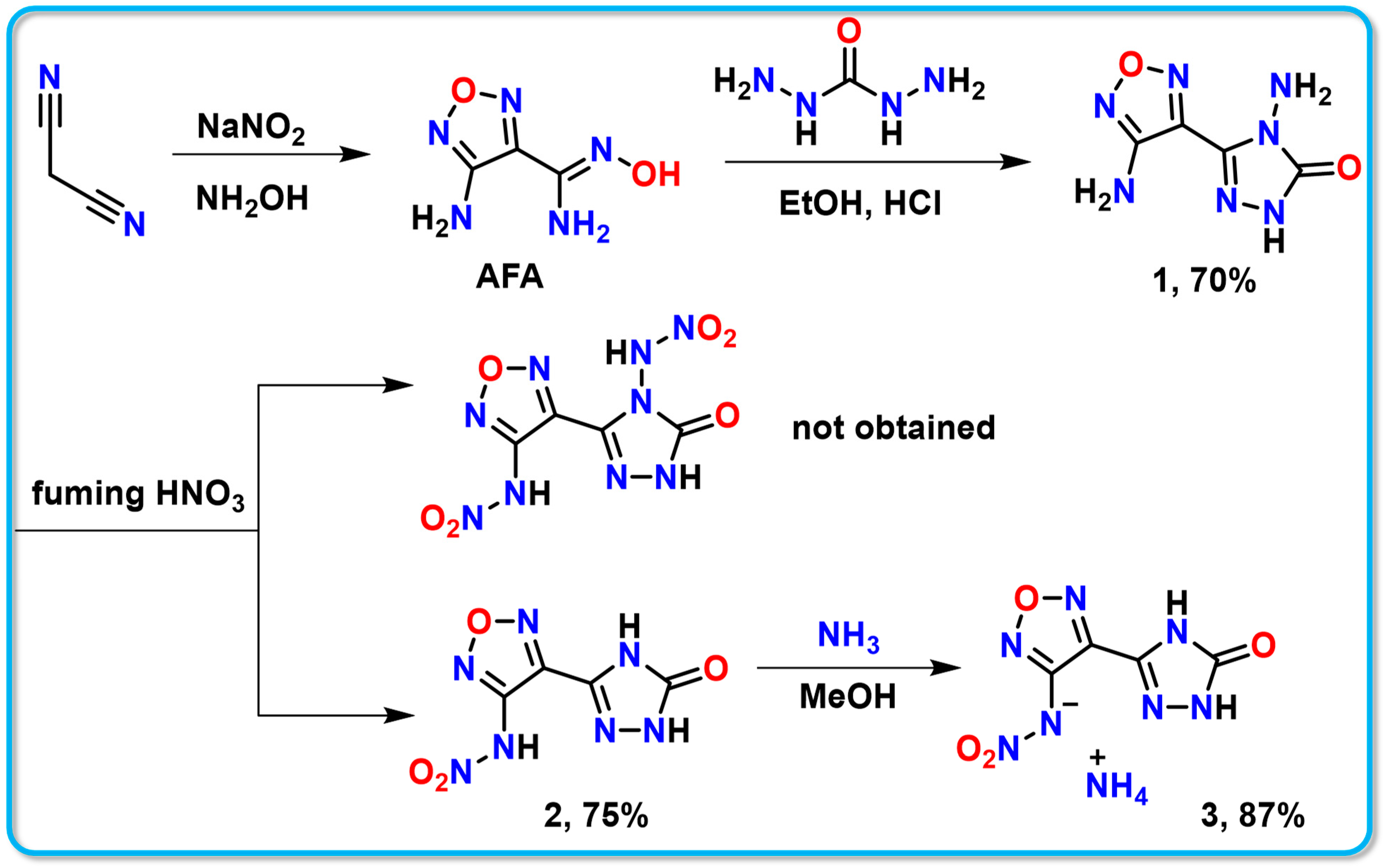
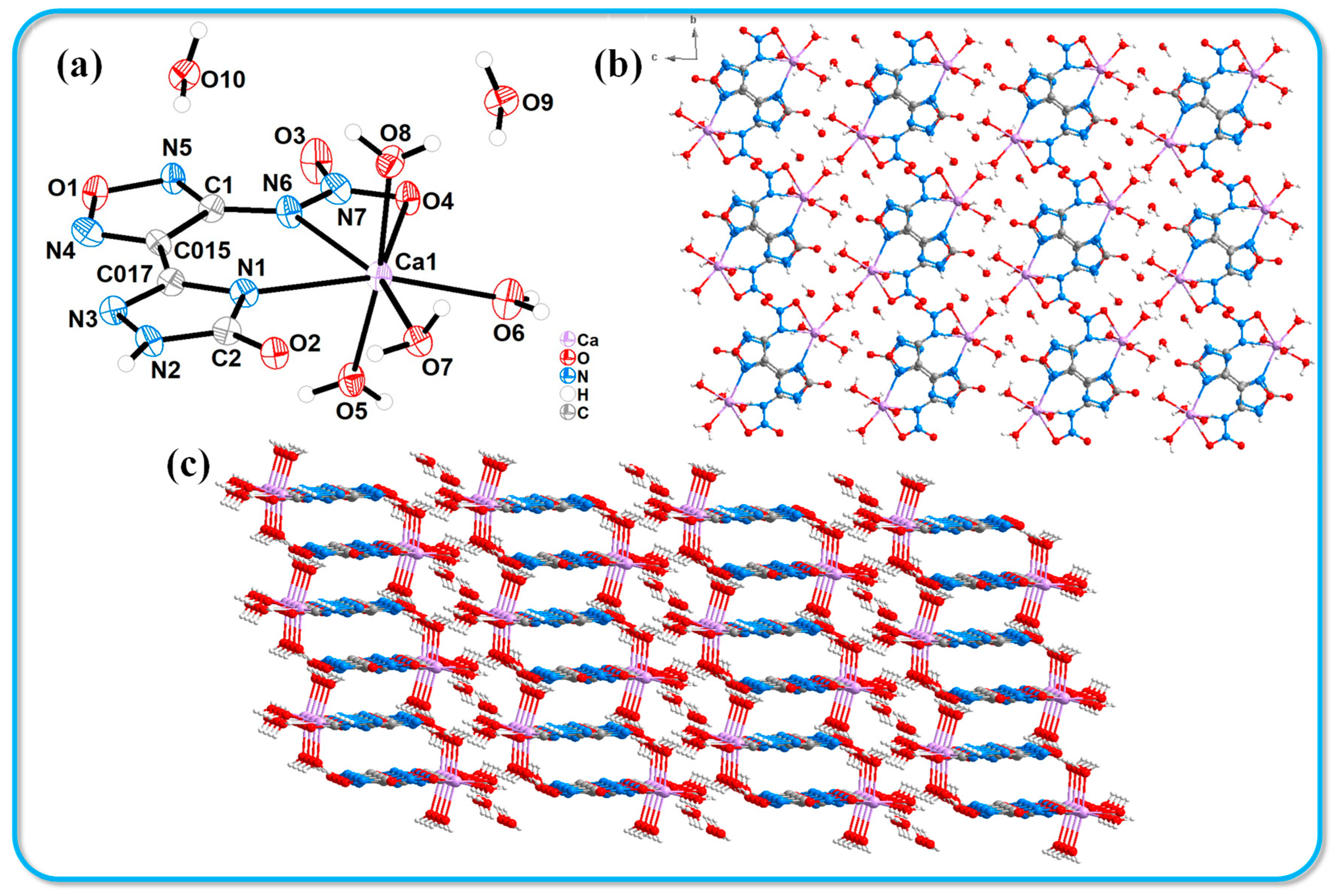
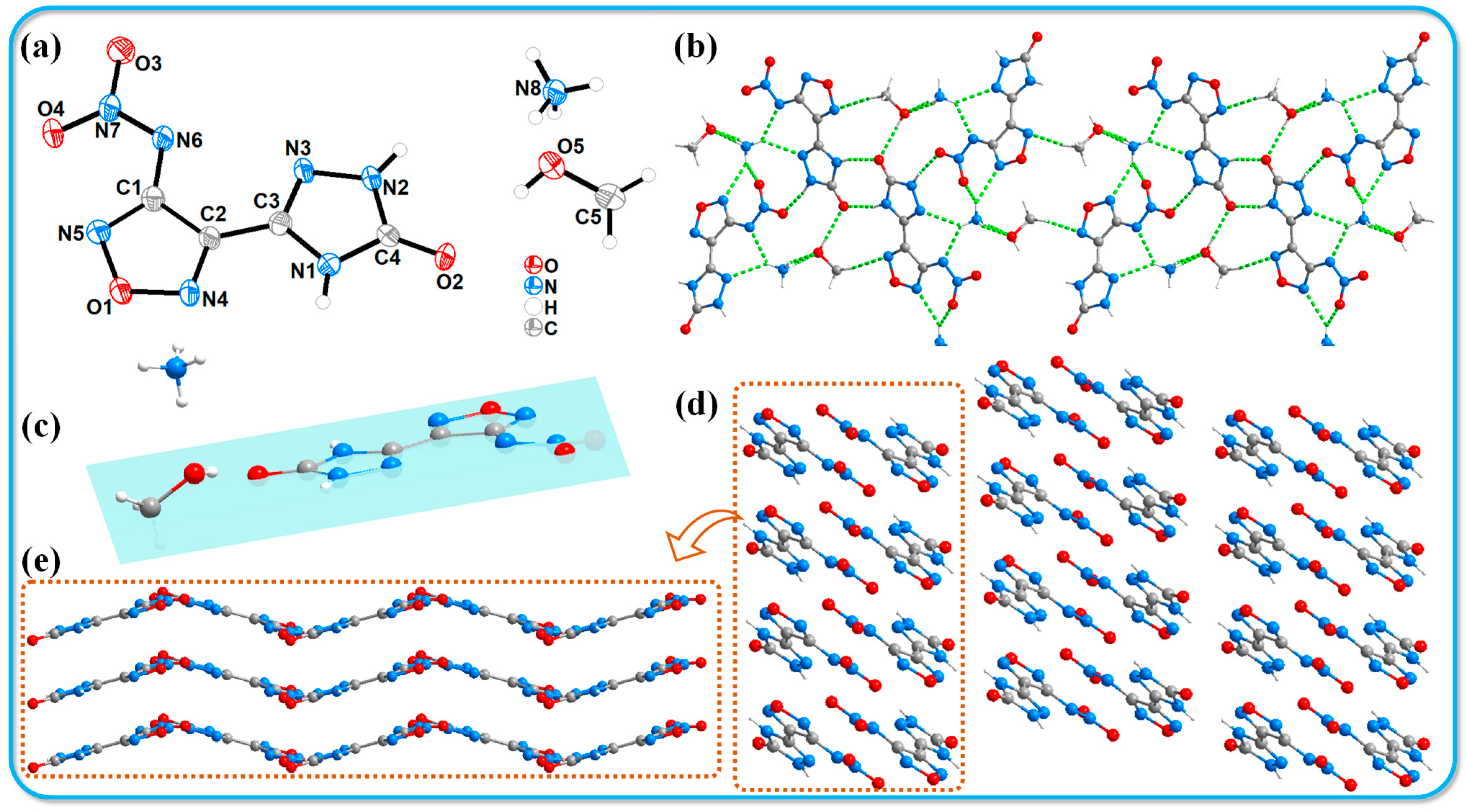
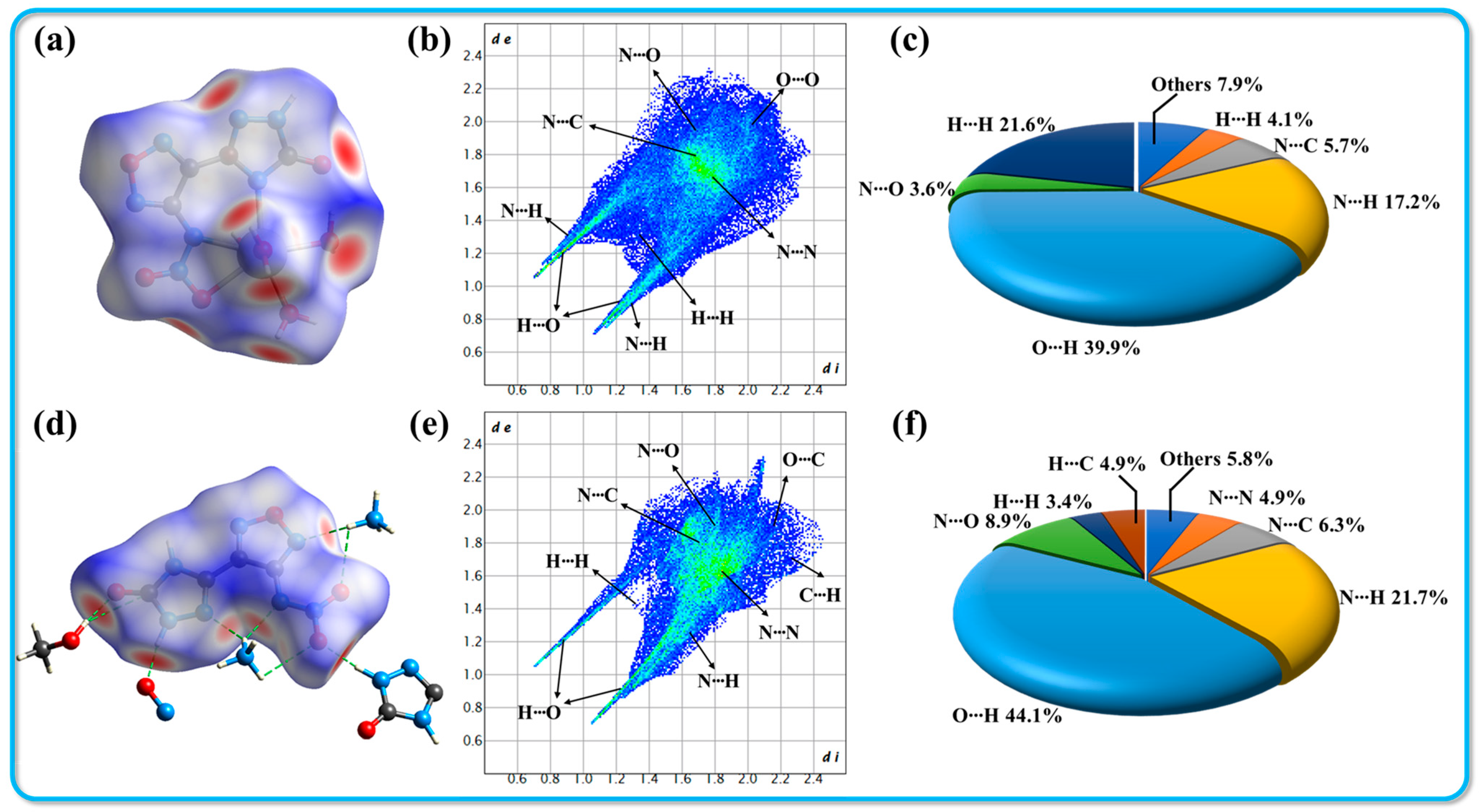
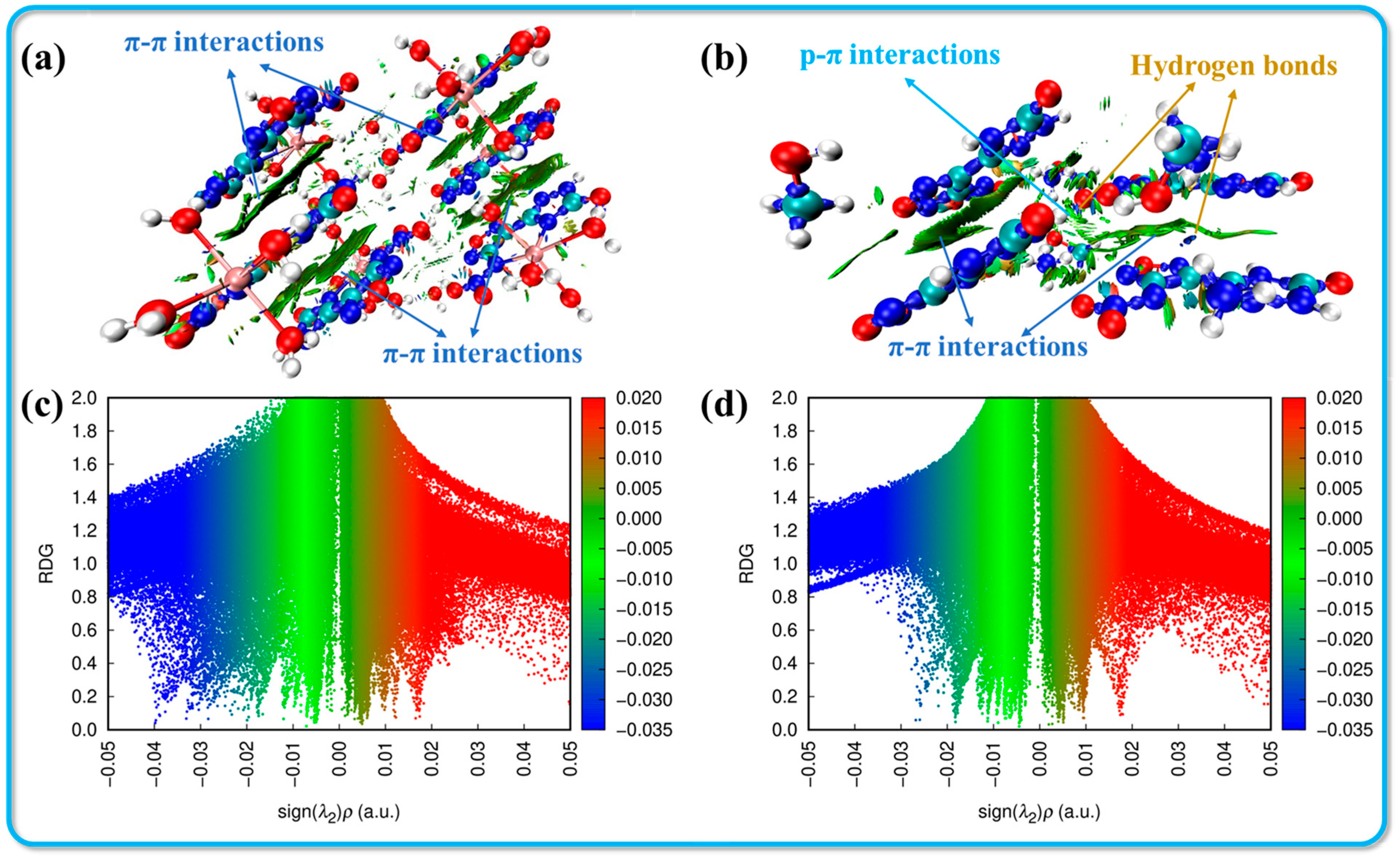



| Compounds | 2·Ca2+·6H2O | 3·MeOH |
|---|---|---|
| Empirical formula | C4H13CaN7O10 | C5H10N8O5 |
| Formula weight | 359.29 | 262.21 |
| Temperature/K | 116 | 116 |
| Crystal system | triclinic | monoclinic |
| Space group | P-1 | P21/n |
| a/Å | 6.8232(14) | 4.1568(6) |
| b/Å | 9.6903(19) | 12.7839(19) |
| c/Å | 10.997(2) | 20.122(3) |
| α/° | 81.535(17) | 90.00 |
| β/° | 76.670(18) | 92.021(13) |
| γ/° | 78.334(17) | 90.00 |
| Volume/Å3 | 689.0(2) | 1068.6(3) |
| Z | 2 | 4 |
| ρcalcg/cm3 | 1.732 | 1.630 |
| μ/mm−1 | 0.524 | 0.143 |
| F(000) | 372 | 544 |
| Crystal size/mm3 | 0.23 × 0.15 × 0.15 | 0.35 × 0.13 × 0.09 |
| 2θ range for data collection/° | 6.06 to 52 | 6.38 to 52 |
| Index ranges | −7 ≤ h ≤ 8, −11 ≤ k ≤ 9, −13 ≤ l ≤ 11 | −5 ≤ h ≤ 5, −15 ≤ k ≤ 11, −20 ≤ l ≤ 24 |
| Reflections collected | 4599 | 4251 |
| Independent reflections | 2618 [Rint = 0.0546 (inf-0.9 Å)] | 2060 [R(int) = 0.0698 (inf-0.9 Å)] |
| Data/restraints/parameters | 2618/22/235 | 2060/0/166 |
| F2 | 1.045 | 1.048 |
| Final R indexes [I ≥ 2σ (I)] | R1 = 0.0697, wR2 = 0.1495 | R1 = 0.0729, wR2 = 0.1681 |
| Final R indexes | R1 = 0.1090, wR2 = 0.1876 | R1 = 0.1254, wR2 = 0.2059 |
| CCDC | 2441168 | 2441167 |
| Compounds | ρ a [g·cm−3] | Td b [°C] | ΔHf c [kJ·mol−1] | D d [m·s−1] | P e [GPa] | IS f [J] | FS g [N] |
|---|---|---|---|---|---|---|---|
| 2 | 1.60 | 94 | 56.2 | 7689 | 28.9 | 12 | 120 |
| 3 | 1.64 | 233 | 121.0 | 8120 | 32.1 | 24 | 224 |
| TNT | 1.65 | 295 | −67.0 | 6881 | 19.5 | 353 | 36.5 |
Disclaimer/Publisher’s Note: The statements, opinions and data contained in all publications are solely those of the individual author(s) and contributor(s) and not of MDPI and/or the editor(s). MDPI and/or the editor(s) disclaim responsibility for any injury to people or property resulting from any ideas, methods, instructions or products referred to in the content. |
© 2025 by the authors. Licensee MDPI, Basel, Switzerland. This article is an open access article distributed under the terms and conditions of the Creative Commons Attribution (CC BY) license (https://creativecommons.org/licenses/by/4.0/).
Share and Cite
Xu, M.-Q.; Dong, W.-S.; Tariq, Q.-u.-N.; Zhang, C.; Li, C.; Lu, Z.-J.; Zhao, B.-S.; Yu, Q.-Y.; Zhang, J.-G. Synthesis, Characterization, and Properties of Novel Coplanar Bicyclic Compounds Based on Triazolofurazane Compounds. Molecules 2025, 30, 2803. https://doi.org/10.3390/molecules30132803
Xu M-Q, Dong W-S, Tariq Q-u-N, Zhang C, Li C, Lu Z-J, Zhao B-S, Yu Q-Y, Zhang J-G. Synthesis, Characterization, and Properties of Novel Coplanar Bicyclic Compounds Based on Triazolofurazane Compounds. Molecules. 2025; 30(13):2803. https://doi.org/10.3390/molecules30132803
Chicago/Turabian StyleXu, Mei-Qi, Wen-Shuai Dong, Qamar-un-Nisa Tariq, Chao Zhang, Cong Li, Zu-Jia Lu, Bin-Shan Zhao, Qi-Yao Yu, and Jian-Guo Zhang. 2025. "Synthesis, Characterization, and Properties of Novel Coplanar Bicyclic Compounds Based on Triazolofurazane Compounds" Molecules 30, no. 13: 2803. https://doi.org/10.3390/molecules30132803
APA StyleXu, M.-Q., Dong, W.-S., Tariq, Q.-u.-N., Zhang, C., Li, C., Lu, Z.-J., Zhao, B.-S., Yu, Q.-Y., & Zhang, J.-G. (2025). Synthesis, Characterization, and Properties of Novel Coplanar Bicyclic Compounds Based on Triazolofurazane Compounds. Molecules, 30(13), 2803. https://doi.org/10.3390/molecules30132803







